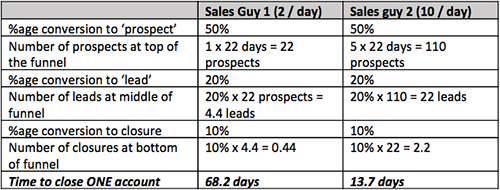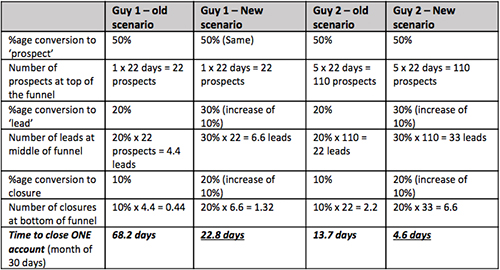After having spent 18 years of selling to corporates, SMBs, channel partners in every model conceivable – direct sales, channel sales, inbound sales, outbound sales, business developmentalish sales (where your contracted customer doesn’t pay – but someone else does), I have come to realize there are some sales metrics which are active and relevant to every one of them. I have listed them here, and would love to hear from other experts/customers if they have any more to add. Also – if there are questions about these, I’d be happy to answer in comments or email.
1. Number of sales calls per day: For any type of sales, I believe this is the biggest, most important sales metric to have. All else being equal, sales comes out to be a function of the “flow” through the funnel, not the various stages in isolation. Each stage is a subset of its immediate predecessor. Let’s look at this mathematically.
You have two sales guys, one of them does two great sales calls a day, and another does 10 sales calls a day. Here is how the numbers will start stacking up post a month:

The percentage conversions have been assumed here, and are not representative of any accurate numbers. Please plug in your own numbers here and see what comes up.
On the whole, and as is evident – the person who does more sales calls is more likely to generate more business. The problem is that many a times, salespeople will wing it, and say that they did X sales calls, but in reality the number was nearer X/2. They count the number of calls placed, picked but no conversation happened as a call. That’s not what you need to measure. A “call” is one where a conversation happened and an outcome came out (either fell off or progressed further).
This is a very big problem for a lot of CXOs and we ourselves weren’t spared. So we created our own solution for it. This solution ensures that not only are they presenting the most relevant and updated content, but as a business head – you also get to know where the person was when he was showing it, and how many times in a day did he show / see it. Effectively – you can now track how many times has a person shown the content, and where all has he shown it. It helped us plan better and manage the sales funnel more realistically. We call it Real Sales.
2. Conversion ratios between the various stages: If you look at the previous chart, you will realize that the second important thing is the percentage conversions that are happening between the various stages. Here we have depicted them as 50% – 20% – 10% along the funnel. However, if you change any of the latter two metrics, your sales numbers would change dramatically. Lets see how:

As you can see – with the same people, doing the same things, but better conversions at specific points in the sales process, you could potentially triple your sales. Nothing changed fundamentally. The people were the same, the processes were the same, the funnel was the same. What happened then? I don’t want this to be a pitch for our product, but what we did worked for us at Capabiliti. Our conversion rates went by from 7% to 16% at the first stage and in the next stage from 6% to 13%. Here it is – take it for what you believe it is worth in your scenario. Its an art to figure out what the sales call was about by speaking with the sales person, and whether or not it will convert to anything, but that’s for another time.
In our case, we audited a few outbound calls and realized that the query handling was a problem, so we setup a simple approach to upskill our sales guys using our video role play technology. We uploaded the value proposition on the platform. Recorded our best sales person pitching the product (was me in this case), and uploaded it. This was then assigned to everyone and the sales person was now asked to record his customer query handling on the platform directly. I reviewed it asynchronously at the backend and advised corrective action. It worked and is now available for everyone to use .
While I don’t undermine the other elements that go into making a sale – these two are to my mind the most significant metrics and also the simplest. They inevitably get overlooked. Do so at your own peril.
Mrigank Tripathi is a serial entrepreneur, and a pioneer in the mobile learning arena. He is currently helping organizations enhance their sales productivity by training and engaging their frontline using Capabiliti – the flagship product of Qustn Technologies, of which he is the founder and CEO. He can be reached at m@qustn.com.


